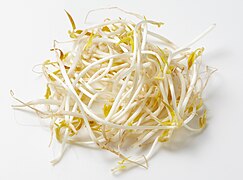Cookbook:Bean Sprout
| Bean Sprout | |
|---|---|
 | |
| Category | Vegetables |
Cookbook | Recipes | Ingredients | Vegetables | Legume
The bean sprout is a very young sprouted bean plant, harvested prior to the development of leaves. It is similar to but not the same as microgreens.[1]
Characteristics[edit | edit source]
Bean sprouts tend to be white to pale yellow in color, with very small little leaves.[2] They are long and crunchy, with a very high water content.[1] Overall, they have an extremely mild, if ever-so-slightly bitter flavor, and they tend to take on the characteristics of the dish they're included in.[2] Care should be taken not to overcook them, as they become translucent, brown, and limp.
Varieties[edit | edit source]
Technically, bean sprouts can be made from any dried, nontoxic pulses;[1] however, certain varieties are more common:
- Mung bean sprouts: some of the more popular and commonly available bean sprouts;[2] long and tubular.
- Soy bean sprouts: similar in appearance to mung bean sprouts, but larger.
- Alfalfa sprouts: thinner and more threadlike,[1] somewhat similar to microgreens; not as thick and "juicy" as the above.
Production[edit | edit source]
Bean sprouts are fairly easy to produce at home from dried pulses, since all that is required is germinating the plants and letting them form shoots.[3] They should be soaked for 8–12 hours in cool water, drained, and placed in a perforated container in the dark and at room temperature.[1] Repeat the washing/draining daily until you have sprouts.[1]
Selection and storage[edit | edit source]
When purchasing bean sprouts, you should only buy those that are crisp and pale. Discard any sprouts that are limp, slimy, or that smell bad.[2]
Bean sprouts should be eaten fresh, and they have a short shelf life.[1] Once you have mature sprouts, they should be kept dry in an airtight container in the fridge[2]—do not wash them until immediately prior to using them.[2] After washing bean sprouts prior to use, discard any that are not crisp and white, then dry them well before using in cooking.[2]
Use[edit | edit source]
Bean sprouts are particularly associated with Chinese cuisine, and with east Asian cuisine in general.[2] Bean sprouts are often added to stir-fry, where they add a crunchy texture. They should be added near the end, because they are very easy to overcook.[4]
Gallery[edit | edit source]
-
Alfalfa sprouts
-
Mung bean sprouts
-
Soy bean sprouts
Recipes[edit | edit source]
References[edit | edit source]
- ↑ a b c d e f g "What are Bean Sprouts?". Food Network. Retrieved 2023-12-23.
- ↑ a b c d e f g h "What Are Mung Bean Sprouts?". The Spruce Eats. Retrieved 2023-12-23.
- ↑ Davidson, Alan (2014-01-01). Jaine, Tom (ed.). The Oxford Companion to Food. Oxford University Press. doi:10.1093/acref/9780199677337.001.0001. ISBN 978-0-19-967733-7.
- ↑ "How to Grow Bean Sprouts in a Jar". Serious Eats. Retrieved 2023-12-23.


